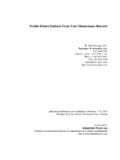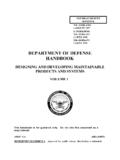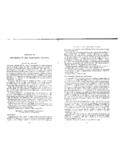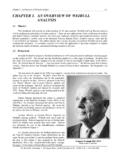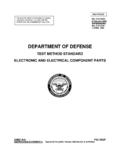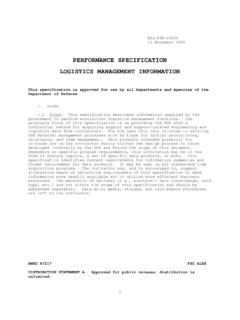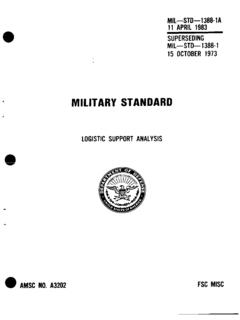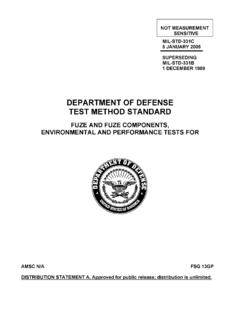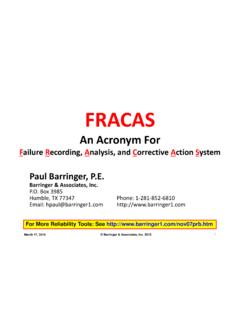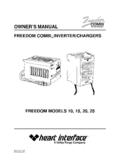Transcription of Life Cycle Cost & Reliability - Barringer1.com
1 life Cycle cost & Reliability for Process EquipmentH. Paul Barringer, & Associates, , TX8th Annual energy WEEK Conference & ExhibitionGeorge R. Brown Convention CenterHouston, TexasJanuary 28-30, 1997 Organized byAmerican Petroleum Institute,2 American Society of Mechanical Engineers,andPennWell Publishing3 life Cycle Costs & Reliability for Process EquipmentH. Paul Barringer, , Barringer & Associates, Inc.,P. O. Box 3985, Humble, TX, Phone: 281-852-6810, FAX: 281-852-3749 ABSTRACTLife Cycle costs (LCC) are cradle-to-grave costs summarizing all ownership costs. Reliability plays animportant role in selection of equipment for lowest long term cost of ownership. Results of a MonteCarlo simulation using an Excel spreadsheet show good maintenance practices (GMP) can alteroutcomes of both cost and Reliability . Maintenance strategies are shown for an API pump using Cycle cost DEFINITIONSLife Cycle costs are summations of estimated cost from inception to disposal for both equipment andprojects as determined by an analytical study and estimate of total costs experienced during the life ofequipment or projects (Barringer 1996a).
2 The objective of LCC analysis is to choose the most costeffective approach from a series of alternatives so the least long term cost of ownership is achievedwhile considering cost elements which include design, development, production, operation, maintenance,support, and final disposition of a major system over its anticipated useful life span. LCC is the sum ofacquisition, logistic support and operating expenses (Landers 1996). LCC is the language of money(Goble 1992).LCC analysis helps engineers justify equipment and process selection based on total costs rather thanthe initial purchase price as the cost of operation, maintenance, and disposal costs exceed all other costsmany times over. Details of LCC have been recently summarized in a tutorial which includes anextensive listing of references (Barringer 1996b).INTRODUCTIONP rocurement costs are widely used as the primary (and sometimes only) criteria for selecting equipmentor systems.
3 This simple criteria is easy to use but often results in bad financial long term costs tell only one part of the story and equipment maintenance tells the rest of the story asequipment failure cost is often many times larger than procurement costs. Procurement of cheapequipment often increases maintenance costs and results in greater LCC. Complete cost details overthe life of the equipment are needed for smart financial decisions, and this requires use of failure details,simulations, and net present value USE LCC?LCC emphasizes economic competitiveness by working for the lowest long term cost of requires many viewpoints to produce cost numbers and thus a teamwork approach is needed for4minimizing LCC. When properly used (along with good engineering judgment), LCC provides a rich setof information for making cost effective, long term decisions in a disciplined uses net present value (NPV) concepts. NPV is an important economic measure for projects orequipment taking into account discount factors, cash flow, and time.
4 Net present value calculations startwith a discount rate, followed by finding the present value of the cash proceeds expected from theinvestment, then followed by finding the present value of the outlays: the net of this calculation is the netpresent value. Cash availability and strategies aside, when competing projects are judged foracceptance, projects with high NPVs usually must be concerned with life Cycle costs for making important economic decisions throughengineering actions. This requires consideration of how and when sustaining costs occur during the lifecycle of the equipment or project. Adding expected equipment failure rates and renewals from astatistical viewpoint makes analysis about economics smarter and gets the rational decisions closer toreal world conditions. Engineers must supply facts (not opinions) for LCC calculations and LCC failuresoccur where teamwork is talked about but not GOES INTO life Cycle COSTS?
5 LCC includes every cost that is appropriate. Appropriateness changes with each specific case which istailored to fit the situation. LCC follows a process (Fabryck 1991 Appendix A):5 Define the problem requiring LCCP repare cost breakdown structure/treeChoose analytical cost modelGather cost estimates and cost modelsMake cost profiles for each year of studyMake break-even charts for alternativesPareto charts of vital few cost contributorsSensitivity analysis of high costs and reasonsStudy risks of high cost items and occurencesSelect preferred course of action using LCCA lternatives and acquisition/sustaining costsFeedback1762345111098 StepTaskFigure 1: life Cycle Costing ProcessThe basic tree for LCC starts with the costs for acquisition and the costs for sustaining the acquisitionduring its life as shown in Figure 2. life Cycle cost TreeSustaining CostsAcquisition CostsFigure 2: Top Levels Of LCC TreeFrequently the cost of sustaining equipment is 2 to 20 times the acquisition cost .
6 Consider the cost for asimple, continuously operating, pump the power cost for driving the pump is many times larger thanthe acquisition cost of the pump. This means pumps must be procured with an emphasis on energyefficient drivers and energy efficient rotating parts while incurring modest increases in procurement coststo save large amounts of money over the life of the equipment. Here is an often cited rule of thumb:65% of the total LCC is set when the equipment is specified!! As a result, do not consider specificationprocesses lightly unless you can afford example has its own unique set of costs and problems to solve for minimizing LCC usingacquisition and sustaining costs details. Each branch of acquisition and sustaining costs depends on thespecific case and is generally driven by common sense. Include the appropriate cost elements anddiscard the elements which do not substantially influence LCC.
7 SAE (SAE 1993) has a LCC modeldirected toward a manufacturing environment as shown in Figure Maint. CostScheduled PriceAdministrative/EngineeringInstallat ionTrainingConversionTransportationDirec t LaborUtilitiesConsumablesWaste-handlingL ost ProductionSpare Parts MaintenanceConversion CostsDecommission CostsSalvage CostsCleaning of SiteWaste/By-product DisposalMaterial & Labor CostsUnscheduled Brkdn. Costs Average cost of RepairCost of Repair Parts/Year life of EquipmentMaterial & Labor CostsCost of PM SchedulesCost of RepairFixed Labor cost For BrkdnLife of EquipmentFigure 3: SAE Model of LCCLCC varies with events, time, and conditions. Many cost variables are not deterministic but areprobabilistic. This usually requires starting with arithmetic values for cost and then growing the costnumbers into more accurate, but more complicated, probabilistic TOOLS FOR LCCOne helpful tool for easing LCC calculations is the effectiveness equation as a figure-of-merit.
8 Theeffectiveness equation is described in several different formats (Barringer 1996b) where each elementvaries as a probability. The main issue is finding the best system effectiveness is an index of value. Value is a measure of relative desirability to create satisfactiondivided by the price (Ireson 1996). The system effectiveness equations uses LCC as the quantity ofprice and effectiveness as the quantity measure of results received:System effectiveness = Effectiveness/LCCE ffectiveness is a measure of relative desirability received (effectiveness rarely includes all valueelements as many are too difficult to quantify) and effectiveness varies from 0 to 1:7 Effectiveness= availability * Reliability * maintainability * capabilityIn plain English, the effectiveness equation is the product of: the chance the equipment or system will beavailable to perform its duty, it will operate for a given time without failure, it is repaired withoutexcessive loss maintenance time and it can perform its intended production activity according to thestandard.
9 Each element of the effectiveness equation is premised on a firm datum, which changes withname plate ratings, to obtain a true value that lies between 0 and 1:Availability deals with the duration of up-time for operations and is a measure of how often the systemis alive and well. It is often expressed as (up-time)/(up-time + downtime) with many different issues deal with at least three main factors (Davidson 1988) for: 1) increasing time to failure,2) decreasing downtime due to repairs or scheduled maintenance, and 3) accomplishing items 1 and 2in a cost effective manner as the higher the availability, the greater is the capacity for making moneybecause the equipment has higher in-service deals with reducing failures over a time interval and is a measure of the odds for failure-free operation during a given interval, , it is a measure of success for a failure free operation. It isoften expressed as R(t) = exp(-t/MTBF) = exp(- t) where is failure rate and MTBF is mean timebetween failure.
10 MTBF measures how often the system will fail. MTBF is a basic figure-of-merit forreliability (or failure rate which is the reciprocal of MTBF) for exponential failure modes. End users of aproduct measure Reliability by problem-free operation (resulting in increased productive capability whilerequiring fewer spare parts and less manpower for maintenance activities which results in lower costs).Suppliers of products measure Reliability by completing a failure free warranty period under specifiedoperating conditions. Improving Reliability occurs at an increased capital cost but brings the expectationfor improving availability, decreasing downtime and associated maintenance costs, improved secondaryfailure costs, and results in a better chance for making money because the equipment is free from failuresfor longer periods of deals with duration of maintenance downtime outages or how long it takes to achievethe maintenance actions compared to a datum.
